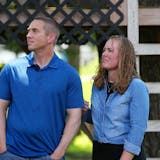Gov. Tim Walz on Tuesday will unveil "surgical" COVID-19 restrictions that target spreaders of the fast-growing infectious disease, as well as plans for mobile device tracking to alert people when they have been exposed to the virus.
Walz on Monday said he wanted to avoid a "blunt" action like the 51-day state lockdown this spring and hinted at early bar and restaurant closures based on where and when customers appear to be spreading the coronavirus that causes COVID-19.
"It makes sense to us now to target those much more surgically, much more aggressively, than a statewide stay-at-home order," Walz said, "because at this point in time, we've learned we can do retail, we can do education, some of it in person, if we're able to test, contain and contact trace those folks to get [their infections] isolated."
The Minnesota Department of Health on Monday reported 19 more COVID-19 deaths and 3,930 infections with the coronavirus that causes the disease. Totals in the pandemic have reached 2,675 deaths and 184,788 diagnosed infections.
The state pandemic dashboard also showed continued pressure on Minnesota hospitals, which as of Monday had admitted 1,084 COVID-19 patients and placed 224 of them in intensive care.
Several doctors urged Walz via social media to order new dial-back restrictions that limit viral transmission and prevent hospitals from being overwhelmed.
"Governor, we need you to exercise your emergency powers to dial back," Dr. Saugar Maripuri, a kidney specialist with Hennepin Healthcare, said in a tweet. "We are at a tipping point with hospital capacity and we cannot afford to run out of ICU beds."



